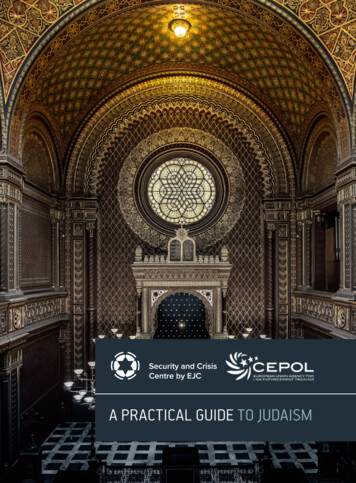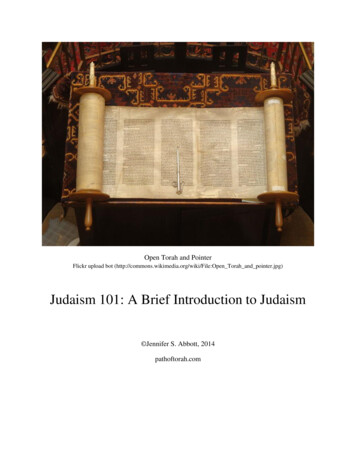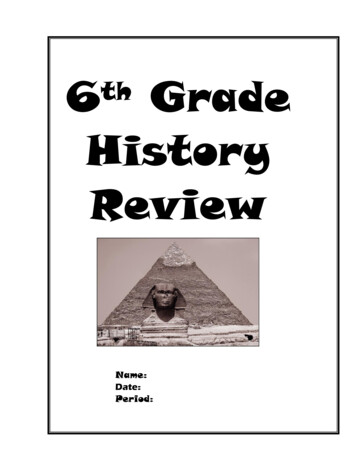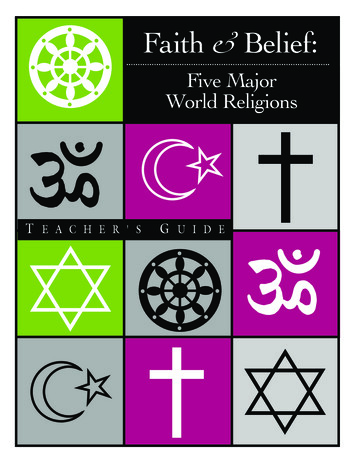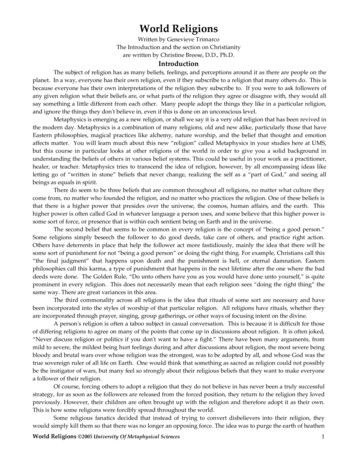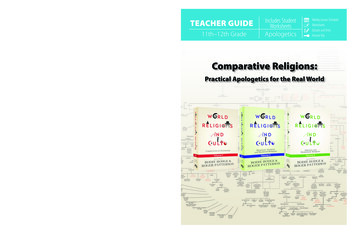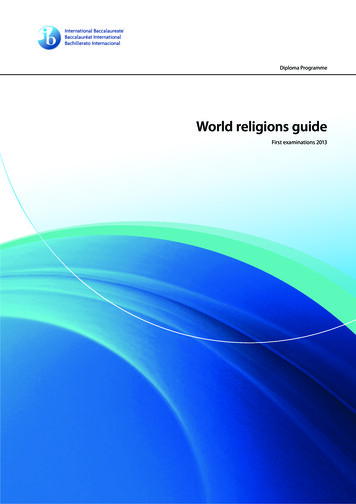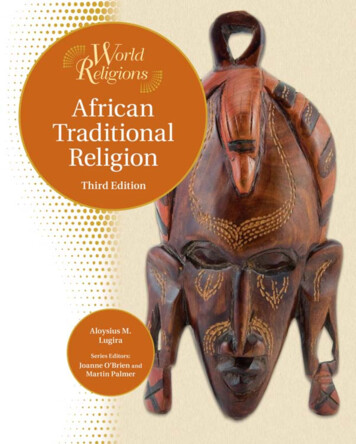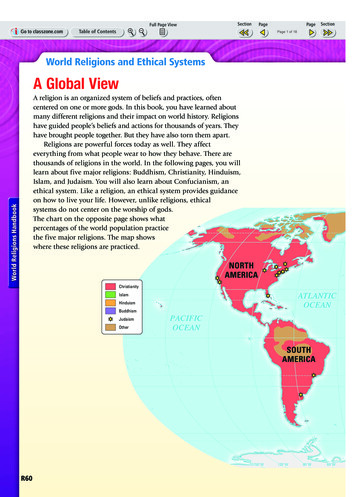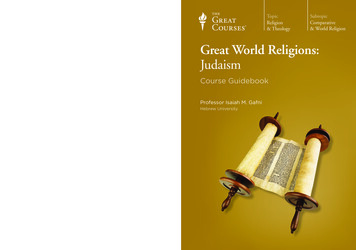
Transcription
TopicReligion& Theology“Pure intellectual stimulation that can be popped intothe [audio or video player] anytime.”—Harvard MagazineGreat World Religions:Judaism“Passionate, erudite, living legend lecturers. Academia’sbest lecturers are being captured on tape.”—The Los Angeles Times“A serious force in American education.”—The Wall Street JournalCourse GuidebookProfessor Isaiah M. GafniHebrew UniversityProfessor Isaiah M. Gafni has taught students about ancientJudaism for more than 40 years at the Hebrew Universityin Jerusalem, where he is the Sol Rosenbloom Professor ofJewish History. His more than 15 books include The Jews ofTalmudic Babylonia: A Social and Cultural History, winnerof the Holon Prize in Jewish Studies. For his exceptionalteaching, Professor Gafni received Hebrew University’sacclaimed Michael Milken Prize.THE GREAT COURSES Corporate Headquarters4840 Westfields Boulevard, Suite 500Chantilly, VA 20151-2299USAPhone: 1-800-832-2412www.thegreatcourses.comCover Image: Tetra Images/Corbis.Course No. 6103 2003 The Teaching Company.SubtopicComparative& World ReligionPB6103A
PUBLISHED BY:THE GREAT COURSESCorporate Headquarters4840 Westfields Boulevard, Suite 500Chantilly, Virginia 20151-2299Phone: 1-800-832-2412Fax: 703-378-3819www.thegreatcourses.comCopyright The Teaching Company, 2003Printed in the United States of AmericaThis book is in copyright. All rights reserved.Without limiting the rights under copyright reserved above,no part of this publication may be reproduced, stored inor introduced into a retrieval system, or transmitted,in any form, or by any means(electronic, mechanical, photocopying, recording, or otherwise),without the prior written permission ofThe Teaching Company.
Isaiah M. Gafni, Ph.D.Professor of Jewish StudiesThe Hebrew University of JerusalemProfessor Isaiah M. Gafni (Ph.D., HebrewUniversity) is the Sol Rosenbloom Professorof Jewish History at the Hebrew Universityof Jerusalem and serves as the Director of GraduateStudies at the Rothberg International School of theHebrew University. Dr. Gafni was born in New YorkCity in 1944 and moved to Israel in 1958, where hereceived all his professional training. Dr. Gafni has taught at the HebrewUniversity for 35 years, while frequently also serving as visiting professor atnumerous universities in the United States, among them, Harvard, Yale, andBrown. He was also honored in 1994 as the Louis Jacobs Fellow in RabbinicThought at Oxford University, where he delivered a series of lectures on theJewish diaspora in the Greco-Roman period.Dr. Gafni has written or edited 14 books on various aspects of Jewish historyin late antiquity, as well as numerous scholarly articles (including morethan 100 entries in the Encyclopaedia Judaica). Two of his books discussthe history of the Jews in Talmudic Babylonia, for which he was awardedthe 1992 Holon Prize in Jewish Studies. (His work The Jews of TalmudicBabylonia: A Social and Cultural History has recently been publishedin Russian.) One of Dr. Gafni’s recent works, entitled Land, Center andDiaspora: Jewish Constructs in Late Antiquity (Shef¿eld Academic Press,1997), addresses the complex relationships between the Jews of the diasporaand the land of Israel in late antiquity and deals with such topics as Jewishself-de¿nition and the tension between “centrality of land” and “spiritualorientation” in a post-Temple context.Dr. Gafni has devoted much effort to the dissemination of Jewish historicalknowledge on a popular level, as well. He was on the founding faculty ofIsrael’s Open University and wrote its ¿rst course in Jewish studies andthe humanities (“From Jerusalem to Yavne”). For many years, Dr. Gafnii
served as chairman of the publications committee of the Shazar Center forJewish History, an extension of the Israel Historical Society. In 1996, Dr.Gafni was awarded the Hebrew University’s Michael Milken Prize forexceptional teaching. Ŷii
Table of ContentsINTRODUCTIONProfessor Biography .iCourse Scope .1LECTURE GUIDESLECTURE 1What Is Judaism? .4LECTURE 2The Stages of History .10LECTURE 3The Jewish Library .17LECTURE 4The Emergence of Rabbinic Judaism.23LECTURE 5Jewish Worship—Prayer and the Synagogue .27LECTURE 6The Calendar—A Communal Life-Cycle.32LECTURE 7Individual Life-Cycles.37LECTURE 8God and Man; God and Community .42LECTURE 9Philosophers and Mystics .46iii
Table of ContentsLECTURE 10The Legal Frameworks of Judaism—Halakha.51LECTURE 11Common Judaism—or a Plurality of Judaisms? .56LECTURE 12Judaism and “Others” .62SUPPLEMENTAL MATERIALTimeline .66Glossary .69Biographical Notes .74Bibliography .79iv
Great World Religions: JudaismScope:Afrequently quoted story in rabbinic literature describes how apotential convert to Judaism approached two rabbinic sages of the 1stcentury B.C.E., requesting to be taught the entire corpus of Jewishteaching (the Torah) while standing on one foot. The ¿rst rabbi, Shammai,had little patience for such a frivolous request and responded by striking theenquirer with a rod he happened to be holding. The other sage, Hillel, repliedby reciting one line that to his mind, indeed contained the essence of theTorah (I will divulge this line in Lecture 1). He then suggested that all therest is merely commentary but urged the potential convert to go and study itnevertheless.As we embark on a 12-lecture overview of Judaism, I can only empathize withthose two sages and the predicament that confronted them; indeed, I wonderwhether I should not have opted for Shammai’s path when approached toproduce this course.This story stresses the idea that the request for a succinct presentation of theessence of Judaism came from an outsider looking in. As we will see in theselectures, however, Jews throughout history have also attempted to formulatebrief summations of the essence or uniqueness of Judaism. The variety ofsuggestions, as well as the opposition at times to the very notion that this canbe achieved without inadvertently relegating everything else to a secondarystatus, will inform us signi¿cantly on the diversity of Jewish self-de¿nitionthroughout history.The purpose of these lectures is to present Judaism from within, as it wasunderstood by its adherents in the past and by those who practice or identifywith Judaism today. That there are so many differences between past andpresent and, similarly, among Jews today, only attests to the impact thatevents and ideas throughout history have had on the nature of Jewishexpression and behavior and the vitality with which Jews addressed those1
changes while seeking to maintain a link and a sense of continuity with theirancient heritage.The ¿rst three lectures provide a necessary overview and context for allour subsequent discussions. The opening lecture raises the question ofwhether Judaism is indeed a “religion” in the same sense that Christianityand Islam are religions. The second lecture offers a historical overview forunderstanding many of the subsequent issues to be taken up; it focuses onthe “shared memory” or “collective history” of the earliest stages of Judaism,primarily the biblical and immediately post-biblical periods.The third lecture introduces the major components of the Jewish library,inasmuch as almost every discussion of Judaism refers to written texts asthe underpinnings of Jewish belief and practice. The fourth lecture helps toexplain why Judaism, as it is practiced today, appears so different from thereligion of the Hebrew Bible, which ostensibly is the basis for all subsequentJewish behavior. The crucial event discussed here is the destruction of theSecond Jewish Temple by the Romans in the year 70 C.E. and the necessaryreformulation of much of Jewish tradition and practice in the wake of thatwatershed of Jewish history. Lectures 5 through 7 present the numerous waysin which Judaism manifests itself in the lives of its adherents on a personallevel. These lectures introduce us to the way Jews worship, the yearly cycleof the Jewish calendar, and the outstanding events and rites of passage in aJewish individual’s lifetime.ScopeThe eighth lecture brings us back to an issue already addressed in our openingdiscussion, namely how Jews understood the role of God in their lives. Here,however, we will examine more fully what Jews believed to be the nature oftheir relationship with God, both as individuals and as members of a distinctcommunity.The ninth lecture continues our examination of the variety of approachesembraced by Jewish thinkers in attempting to articulate, to themselves andoften to others, their understanding of how the world functions and whatman’s role in that world should be. Frequently, these examinations were theresult of confrontation and outright religious polemics, but no less important2
were intellectual and phenomenological crosscurrents that permeated Jewishsociety. Philosophers and mystics serve as the major focus of this lecture.The tenth lecture investigates the legal aspects of Judaism. Beginning withthe Hebrew Bible, Judaism produced a detailed legal system (Halakha) thataddresses both the sacred and the seemingly secular aspects of life. Thislecture also examines the status of Halakha among other branches of thecontemporary Jewish community, thereby setting the stage for the eleventhlecture, which looks at the phenomenon of diversity in the world of Judaism.We consider the fact that diversity did not lead to total fragmentation andirreparable schisms. In discussing major groupings or denominations inJudaism today, we also examine the nature of the current challenge to unityand how different it is from earlier versions.Our ¿nal lecture takes up the role and perception of “others” in Jewishthought. The tension between universalism and particularism, betweenGod the Creator of the world and God who redeemed Israel from Egypt,is a constant factor not only in the Bible but in ongoing Jewish thought.Although our ¿rst lecture notes the ethnic component of Judaism, ethnicitynever represented an impenetrable barrier preventing others from becomingfull-Àedged adherents of Judaism, as well as equal members ofthe community. Ŷ3
What Is Judaism?Lecture 1The overriding goal of this course will be to present Judaism fromwithin, as its practitioners understood it.CLecture 1: What Is Judaism?hristianity and Islam are faiths, or “systems of beliefs,” thatembrace diverse communities and ethnic groups throughout theworld. Although Judaism also adheres to particular beliefs andpractices, many Jews would nevertheless consider the designation ofJudaism as a “religion” (or only a religion) as a far too narrow or con¿ningcategorization.Judaism identi¿es its historical roots in the Hebrew Bible, referred to byChristians as the “Old Testament.” In that work, the ancestors and adherentsof the system of beliefs we will discuss in this course were a distinct people,or nation, known as Israel. Biblical Israel considered its destiny attachedto a particular land and linked its faith in God with God’s promise to givethat land to the offspring of Israel’s founding patriarch, Abraham. For muchof the biblical period, Israel was ruled as a monarchy (at ¿rst united, thendivided into two smaller kingdoms). The monarchal dynasty of Israel, goingback to King David, would serve as a symbol of unity and, ultimately, as thefocus of belief in a future restoration. The biblical Israelites were instructedto refrain from intermarriage with surrounding tribes that might corrupt theirfaith; this enhanced even further the ethnic character of the adherents to theIsraelite faith.The origins of the word Judaism also point to the ethnic and geographicalroots of the phrase, rather than to a solely religious entity. Judah was thefourth son of the patriarch Jacob, son of Isaac and grandson of Abraham, thebiblical progenitors of “the People of Israel.” Israel was the subsequent namegiven to Jacob in the biblical book of Genesis. With the establishment of anIsraelite kingdom, the monarchy that would rule over it for approximatelyfour centuries was founded by King David, a descendant of the tribe ofJudah. The kingdom would ultimately go by the name of Judah; thus, thename took on a political, as well as geographical, signi¿cance.4
Jews (or Judaeans) were, in the ¿rst instance, those people either living inthe land of that name or whose roots were in that land, even if their ancestorshad chosen to live elsewhere or had been forcibly removed from it in thecontext of some military conquest. It was only in the Hellenistic period (2ndcentury B.C.E.) that the word Judaism (or Ioudaismos in Greek) appearedfor the ¿rst time, as the designation of a culture, or “way of life,” maintainedby those people linked to the land of “Judaea.”The term Judaism appears for the ¿rst time in the Second Book ofMaccabees (2:21; 14:38), a work written by a Jew living in a Greek-speakingenvironment and describing the clash between the Jews of Judaea and theHellenistic rulers of that territory, the Syrian Seleucid monarchy and its king,Antiocus IV Epiphanes (175–162 B.C.E.). That same book also contains theearliest use of the term Hellenism.Notwithstanding the national and ethnic components of Judaism, religion,expressed as a system of beliefs and practices, was certainly a criticalcomponent of Jewish self-perception. Over the centuries, various attempts atde¿ning the essence of that religion have been made.Some attempts have designated portions of biblical Scripture as representingthe essence of what would emerge as Judaism. One common belief is thatJudaism is summarized in the Decalogue, or Ten Commandments, givenby God to Israel at Mount Sinai(Exod. 20:1–14; Deut. 5:6–18).These commandments, as noted in The ancestors and adherentslater rabbinic literature, compriseof the system of beliefs we willthe dual foci of the Jewish religion.The ¿rst ¿ve deal with relations discuss in this course werebetween man and God, such as a distinct people, or nation,the requirement to believe in the known as Israel.one God, worship no other deities,and refrain from referring toGod’s name in vain (such as by taking false oaths; interestingly, the ¿fthcommandment, to honor one’s parents, was justi¿ed by later rabbis as partof man’s commitment to God). The latter ¿ve regulate relations amonghumans, by prohibiting murder, adultery, stealing, and so on. In the ¿rst5
centuries C.E., we actually ¿nd some rabbinic ¿gures opposed to the specialrole of the Ten Commandments in synagogue liturgy, because this rolemight render a secondary status to all the other portions of the Bible. Otherattempts have focused on a particular biblical Scripture, such as the prophetHabakuk’s statement: “The righteous [person] shall live by his faith” (Hab.2:4). According to this approach, the dominant element is a trust in God,with apparently everything else evolving from this.Lecture 1: What Is Judaism?Common to these attempts to represent the essence of Judaism is the wish notto go beyond the biblical text itself, by enunciating a more comprehensive anddetailed creed. Nevertheless, Judaism has been subjected to a wide variety ofpost-biblical attempts at isolating what was considered to represent the mostbasic components of the faith. Although it states that “all Israelites have ashare in the world to come,” the rabbinic text known as the Mishnah (wewill discuss this work in Lecture Three) lists the following exceptions: Onewho says that there is no resurrection of the dead prescribed in the Torah;one who says that the Torah is not from heaven (that is, not of divine origin),and an Epicurean (the rabbis adopted the name of the well-known Greekphilosopher as a symbol of heretic beliefs).In rabbinic discussions of martyrdom and the conditions that would justifyaccepting death rather than transgressing the law, the bottom line rendersthe maintenance of life supreme, save for three transgressions that must beavoided at all costs, even if martyrdom is the only alternative. These threesins are: idolatry, forbidden sexual relations, and the shedding of blood(that is, murder). Hillel, replying to a convert’s request for a crash course inJudaism, reduces the entire Torah to one principle: “What is hateful to you,do not do to your fellow man.”These attempts, however, are not presented as creedal af¿rmations orcatechisms, and such formulations are signi¿cantly missing from the rabbinicliterature of the ¿rst centuries C.E. In the Middle Ages, however, the searchfor the “roots,” or essence, of Judaism became more common. The search forthe “principles” of the Jewish religion was probably motivated, or partiallyencouraged, by a number of external factors. The contemplative activity ofIslamic theologians, known as kalam, and their speculations regarding thenature of religious faith, spread to Jewish thinkers as well. Confrontation6
and frequent polemics with the Christian and Moslem worlds enhanced theperception of a need to articulate the differences between Judaism and thetwo other monotheistic faiths.The most famous attempt at formulating a list of Judaism’s “principles” wasmade by the renowned Jewish philosopher of the 12th century, Maimonides,replying to a convert’s request:ƔƔƔƔƔƔƔƔƔƔƔƔThe existence of God. God’s unity.God has no corporeal aspect.God is eternal.God alone (and no intermediaries) should be worshipped.Belief in prophecy.Moses was the greatest of prophets.All of the Torah in our possession is divine and was giventhrough Moses.The Torah will not be changed or superseded.God knows the actions of man.God rewards those who keep the Torah and punishes those whotransgress it.Belief that the Messiah will come.Belief in the resurrection of the dead.Some of these principles were apparently aimed at refuting what Maimonidesbelieved were major challenges posed by Islam and Christianity. Theseventh principle clearly rejects the roles ascribed to Muhammad and Jesusin Islam and Christianity. The ninth principle is a direct response to claimsfor supersession of the Torah and abrogation of the practices laid out in thatcorpus by the subsequent teachings of the two younger religions.Maimonides’s formulation appeared at ¿rst as a commentary to the Mishnah,but by the 16th century, it was published with each of his principles precededby the af¿rmation: “I believe with absolute faith that ” This type offormulation is the ¿rst actual presentation of a catechism in Judaism andwas clearly inÀuenced by similar phenomena in the Christian world. The listof principles ultimately found its way into Jewish prayer books and was the7
Library of Congress, Prints and Photographs Division, LC-USZ62-30674.basis for a popular poem, knownas the “Yigdal hymn,” sung tothis day in synagogues.Lecture 1: What Is Judaism?Although ultimately embracedby broad segments of thetraditional Jewish community,Maimonides’s list engendereda widespread reaction amongJewish thinkers after itsappearance. Some attemptedto shorten the list; others, tore¿ne it or add certain aspectsMaimonides (1135–1204), a Jewishthey considered to have beenphilosopher, developed a list ofoverlooked, while yet otherselements that characterized his religionopposed the whole enterprise.and distinguished it from other faiths.Noteworthy among these wasIsaac Abravanel. Writing around the year 1500, he maintained that the verynotion of “principles” in the Torah suggests differing levels of sanctity ortruth in that very same text, thereby also encouraging a sort of heresy.By listing principles of faith, Maimonides was not ignoring the ethnicor communal aspect of Judaism. Following his enumeration of the 13principles, he states that one who does not believe in any of these principleseffectively removes himself from the community of Israel. The link betweenthe communal and the spiritual components of Judaism has found otherexpressions, as well. The central work of Jewish mysticism, the Zohar, is thesource for the statement that God, Israel, and Torah are one; that is, they areinseparably linked. Modern realities would inject new thinking regarding therelationship between the communal and religious aspects of Judaism.The attempts by Western societies in the 18th century to grant Jews equalrights (“emancipation”), while encouraging them to embrace the valuesand social mores of their modern surroundings, ultimately led to attemptsby some Jews to downplay the communal and national roots of Judaismand stress the religious component. The two results of this new de¿nitionof Judaism were frequently either outright assimilation into the new open8
society or a reforming of Jewish practice and beliefs that would, it washoped, render them more adaptable to the new political and social realities.In the 19th century, we encounter Jews for whom all religious manifestationsof Judaism were unacceptable, and here, the pendulum will swing in thetotally opposite direction, toward a heightened rediscovery of the nationaland ethnic components of Judaism. Of the many political groups to emergefrom this reappraisal, the national Jewish movement known as Zionismwould have the greatest impact. ŶEssential ReadingDe Lange, Nicholas. An Introduction to Judaism. Cambridge: CambridgeUniversity Press, 2000.Supplemental ReadingNeusner, Jacob. Judaism: An Introduction. London: Penguin, 2002.Seltzer, Robert M. Jewish People, Jewish Thought: The Jewish Experiencein History. New York: Macmillan, 1980.Questions to Consider1. Do you think that most Jews in the United States today would considerJudaism a religion, or would they prefer a different de¿nition?2. Why do you think that many Jewish thinkers were not eager to formulatelists of principles to which all Jews must adhere?9
The Stages of HistoryLecture 2Past and present come together in much of Judaism’s self-image,resulting in a variety of practical manifestations.FLecture 2: The Stages of Historyor Jews, there is a collective past that contributes enormously to theirsense of unity and without which Judaism cannot be understood. Thecollective memory in Judaism is not merely a sequence of events thatonce transpired, but a story to be studied, transmitted, and in certain cases,even re-lived. The liberation, or exodus, of the Israelites from Egypt is notonly discussed but, in a sense, re-lived at the yearly festival of Passover.Rabbinic tradition proclaims that the souls of all the future adherents toJudaism were actually present at the revelation of God at Mount Sinai. Jewsmourn the destruction of the two Temples in Jerusalem to this day, with aseries of fast days commemorating the various events connected to theseancient watersheds in Jewish religious tradition. Jews at prayer frequentlyturn to the past as part of their supplications regarding the present (or thefuture). Divine promises to the biblical patriarchs, or examples of their perfectfaith, serve as arguments in petitioning God to have pity on their descendantsin the present. Judaism represents an ongoing but constantly changing sagaof 4,000 years. Each period left its distinct mark; thus, although certain basicbeliefs were ¿xed, new expressions were constantly being added—or takingthe place of earlier ones.The biblical period spans a period of 1,400 years. It begins with the earliestroots of the patriarchal family of Israel and its intimate relationship with God.The Bible then records the stages leading to the emergence of the Israelitesas a nation: their liberation from bondage; acceptance of a body of teaching(Torah), revealed to them through Moses; and ¿nally, the establishment of akingdom in the land promised to their patriarchs.Israelite history and religion both begin with the same ¿gure: the patriarchAbraham. Abraham is not only the progenitor of the Israelite people but alsothe father of its faith. He is described in the Bible as “having faith in God”(Gen. 15:6) and would later be perceived as the ¿rst human both to recognize10
God’s existence and to remove himself from the pervasive idolatrous cultureof his day.Abraham’s faith is later tested by God’s commandment and Abraham’swillingness to sacri¿ce his son Isaac. The story became a de¿ning momentfor Jews throughout history, whose willingness to accept all sorts of painand adversity while remaining steadfast in their faith would repeatedly becompared to that of their patriarch Abraham. In later Jewish liturgy, God isrepeatedly asked to remember Abraham’s total commitment as justi¿cationfor forgiving his seed’s frequent lapses. In later times, the rabbis projectAbraham as also seeking converts to Judaism.The events surrounding the patriarchs represent the earliest strands of acollective memory that binds all the subsequent adherents to Judaism.As such, our interest is not in establishing their historicity, nor does theBible itself attempt to contextualize these stories into a broader historicalframework. It should, however, be noted that scholars have tended to placethe migratory processes alluded to in the stories of the patriarchs somewherewithin the 20th and 16th centuries B.C.E.The second critical stage in the biblical account of Israel’s emergence as anation is the bondage of Abraham’s descendants in Egypt for hundreds ofyears, culminating with their exodus from that land under the leadership ofMoses. The biblical book of Genesis has God informing Abraham centuriesin advance of this process; this would lend a crucial sense of providentialinvolvement in all the subsequent history of Israel, thereby stressing thatnothing in the nation’s history transpires by chance.The centuries of bondage in Egypt coincide with Israel’s transformationfrom an extended family of some 70 people to a nation of hundreds ofthousands. Preceded by divine intervention and punishment of the Egyptiansfor their cruel enslavement, the Israelites are led out of Egypt by Moses,the most important ¿gure in the emergence of Judaism. The miraculousredemption was destined to become one of the great de¿ning moments in thecollective memory of Judaism, enhanced even more by the ¿rst of God’s TenCommandments: “I am the Lord your God who brought you out of the landof Egypt, the house of bondage. You shall have no other Gods but me ”11
(Exod. 20:2). The liberation from Egypt often serves as a prototype for hopesof a future redemption in Jewish history and is alluded to regularly in Jewishprayer.Lecture 2: The Stages of HistoryWandering in the desert, the Israelites arrive at Mount Sinai, where theultimate revelation takes place. God calls Moses to the top of the mountain,where he stays for 40 days and nights. While on the mountain, Mosesreceives from God a complete system of laws and instruction, which hesubsequently transmits to the Peopleof Israel. This “teaching,” known asThe vast majority of Jewsthe Torah, will serve as the divine basisno longer resided in afor all subsequent aspects of JewishJewish homeland but werelaw and behavior. Traditional Judaismaccepts that all the ¿ve Books ofdispersed throughout landsMoses, the Pentateuch, were dictatedcontrolled by either Moslemby God to Moses at Sinai. The moreor Christian rulers.liberal denominations of contemporaryJudaism, following modern scholarship,have modi¿ed this article of faith by assigning a greater role for humanauthorship of the Torah. Having received their physical freedom and spiritualsubstructure, the ¿nal stage of the primal ethnographic saga was now ready.After wandering for 40 years in the desert, the Israelites, under the leadershipof Moses’s successor, Joshua, capture the land of Canaan, thus ful¿llingGod’s promise to the patriarchs.The subsequent portions of the Hebrew Bible now describe the stages inthe establishment of Israel as a nation in its land. Following conquest anda period of political consolidation under a series of “judges,” a monarchy¿nally emerged. David, the second king of Israel, whose reign is commonlydated to the 10th century B.C.E., was the founder of a monarchical dynastythat would rule Israel for four centuries, until the fall of the Kingdom ofJudah in 586 B.C.E. to the Babylonians.The period of the Davidic monarchy coincides with two major phenomena,both having a lasting effect on Judaism as a religion. David moved his capitalto Jerusalem, and under his son Solomon, a Temple was established as thefocal point of Jewish worship.12
Library of Congress, Prints and Photographs Division, LC-USZ62-12561.Under the monarchy of Solomon, a temple was built in Jerusalem. Henceforth,Jerusalem would have a dual role as both the political capital and religiouscenter of Judaism.The period of the monarchy coincides with the appearance of the greatprophets of Israel. Their teachings, stressing the moral and ethicalimperatives of the nation and its rulers, serve as a cornerstone of Christianity,as well as Judaism. The Jewish reform moveme
Great World Religions: Judaism A frequently quoted story in rabbinic literature describes how a potential convert to Judaism approached two rabbinic sages of the 1 st century B.C.E., requesting to be taught the entire corpus of Jewish teaching (the Tor
